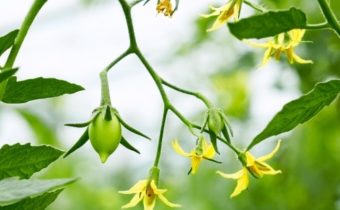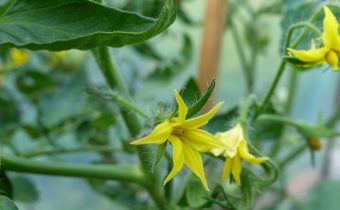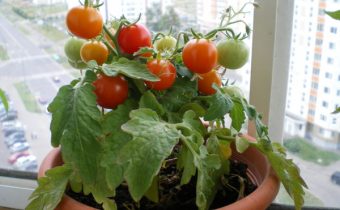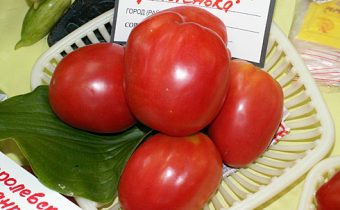Saving tomatoes from blackening - quickly and easily
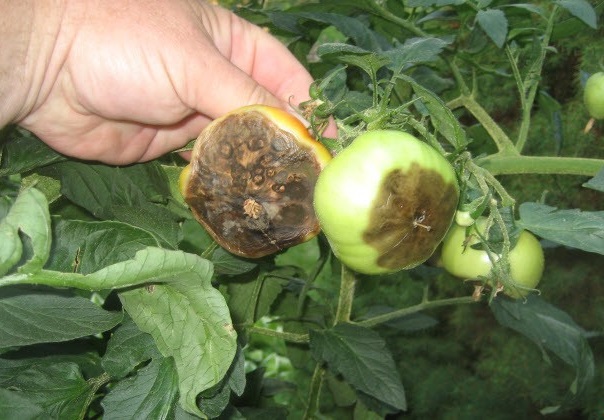
Blackening and decay of tomatoes is a common problem. It can occur because of the many mistakes that almost every gardener makes. Not every blackening is a sign of a disease, it is important to learn to identify the true cause of the disease and learn to cope with it even before its occurrence, using preventive control measures.
Why do tomatoes rot on a bush?
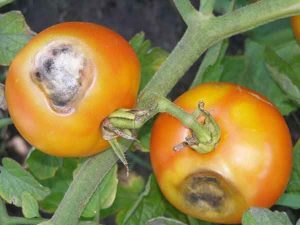 There are a lot of reasons. These are adverse weather conditions, improper care, inappropriate variety of tomatoes for the site. But the most common causes, as shown by years of practice, are described below.
There are a lot of reasons. These are adverse weather conditions, improper care, inappropriate variety of tomatoes for the site. But the most common causes, as shown by years of practice, are described below.
Gray rot
Fungal disease that can destroy almost the entire crop. The danger is that the disease begins to develop actively during the ripening period of tomatoes. Activators can be considered high humidity, unbalanced nutrition with vitamins.
Signs of gray rot development:
- The appearance of gray or brown spots on the fruit;
- darkening on the nodes and stems, which seems to stretch along the surface of the seedling;
- dying off plant tissue;
- the appearance of downy raids;
- the formation of spots on the outer surface of the sheet.
Gray rot instantly affects neighboring seedlings, moving from bush to bush. Tomatoes begin to die, wither and fall. All diseased seedlings dig and burn. It is desirable to dig up the earth and disinfect. Ideal - making a new soil layer. If gray rot was detected in the greenhouse, most likely the cause is increased humidity. Therefore, when growing new seedlings, ventilate the room daily, install window vents so that fresh air circulates around the clock.
Do not use affected bushes as humus. The fungus is difficult to treat and can easily spread to a new crop.
Late blight
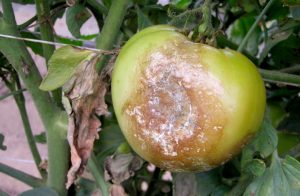 Also applies to fungal diseases. It spreads quite quickly, but unlike gray rot, it is almost impossible to establish the fact of a lesion at the initial stages of development.
Also applies to fungal diseases. It spreads quite quickly, but unlike gray rot, it is almost impossible to establish the fact of a lesion at the initial stages of development.
Favorable conditions for development are windy and high humidity.
Signs of defeat:
- white fluffy coating on the inner surface of the sheet;
- tissue necrosis;
- dark spots on the surface of the fruit;
- as the disease is damaged, the tomatoes acquire an ugly shape, the usual circle is distorted, the applause is dried up;
- softening tomatoes;
- appearance of putrid odor.
Treat seedlings from phytophthora useless. The fungus spreads so quickly through the veins that only preventive measures can be used - that is, the beds are treated in advance with chemicals. When the seedlings are already amazed, tear them out and burn them. As humus, they do not fit, as they infect new shoots.If you want to prevent the development of late blight, then do not plant tomatoes close to the potato, be sure to install supports for the garter of the bushes and inspect the beds as often as possible to identify the object of infection.
Dry soil
This circumstance during the formation of the fruit leads to the formation of top rot, but, as a rule, only in case of exceeding the nitrogen content in the soil. Saplings simply do not have enough strength to fight the fungus. Dry soil leads to the death of the ovaries and the drying of the flowers.
Vertex Rot
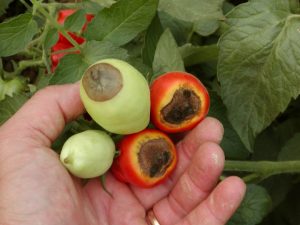 It affects young seedlings that are prepared for fruiting. The disease is not fungal, but bacterial, and therefore does not infect the whole plant at once. Signs of defeat:
It affects young seedlings that are prepared for fruiting. The disease is not fungal, but bacterial, and therefore does not infect the whole plant at once. Signs of defeat:
- flat and depressed watery spots;
- gray-black spots on the fruit;
- suspension in the development and deformation of tomatoes.
The treatment can not be, only prevention, which must begin from the moment of preparation of seeds. after detection of the nidus of the disease, all seedlings must be destroyed and the soil treated.
Do not eat infected fruit in any way. This may adversely affect health.
Brown or dry spotting
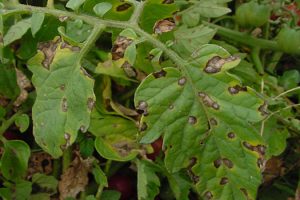 Diseases of the fungal type, which begin to affect the lower leaves of seedlings. As the disease progresses, the spots grow larger and become a gray-brown color, covering more leaves. Gradually the leaves and the stem begin to dry and die off.
Diseases of the fungal type, which begin to affect the lower leaves of seedlings. As the disease progresses, the spots grow larger and become a gray-brown color, covering more leaves. Gradually the leaves and the stem begin to dry and die off.
Fruits become covered with dark depressed spots, and at elevated humidity the spores of the fungus at the site of the lesion begin to multiply by spores, forming a white-fluff coating.
It is possible to fight the fungus with the help of chemical treatment, and if the fruits have already begun to form, then biopreparations will help to cope. In case of severe damage, remove seedlings, and do not eat the affected fruit.
Necrosis of the stem
Necrosis affects the already formed seedlings at the moment when tomatoes begin to form. Signs of necrosis:
- the stem cracks at the bottom;
- cracks of dark green, black color;
- leaves wither;
- Tomatoes do not ripen and fall off.
The virus cannot be cured. Shrubs must be removed from the bed, and the soil treated.
Lack of care
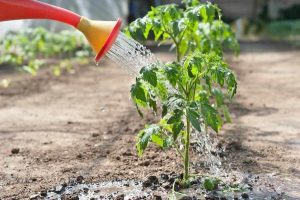 Lack of care, expressed in the absence of tying, improper fertilization or improper watering can lead to rotting seedlings. All varieties of tomatoes, even undersized need to be tied up. Since tomatoes, lying on the ground or tightly adjacent to each other increase the chances of fungal infections and crop death.
Lack of care, expressed in the absence of tying, improper fertilization or improper watering can lead to rotting seedlings. All varieties of tomatoes, even undersized need to be tied up. Since tomatoes, lying on the ground or tightly adjacent to each other increase the chances of fungal infections and crop death.
Excessive amount of nitrogen in case of untimely watering will lead not only to a halt in development, but also to the formation of top rot. And when irrigating with sprinkling on a hot sunny day, it can also lead to the formation of fungal diseases or tissue necrosis.
Watering tomatoes is best at the root. The ideal time is early morning, evening or overcast day.
Why do black tomatoes turn black?
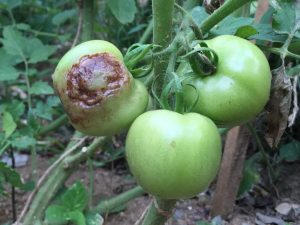 The reasons may be many. The most common are: the defeat of fungal diseases, black rot, late blight. Improper care also causes darkening. Damaged fruit food is strictly prohibited to use, even if the stain is very small.
The reasons may be many. The most common are: the defeat of fungal diseases, black rot, late blight. Improper care also causes darkening. Damaged fruit food is strictly prohibited to use, even if the stain is very small.
Black can also appear from growing on excessively dry soils and soils with a high nitrogen content, as well as if some of the roots look to the surface.
The occurrence of darkening due to lack of magnesium or boron, which need to be replenished by simply feeding the seedlings with trace elements from any manufacturer, but with a high content of missing elements.
Why blacken tomatoes in the greenhouse?
Unlike open ground, the causes of darkening of the surface of the fruit in the greenhouse is much less. As a rule, blackness appears in violation of the temperature regime, high humidity and lack of ventilation.To solve the problem, ventilate the greenhouse room daily or install several air vents for constant circulation of fresh air. Install a thermometer for more accurate temperature control.
Signs of tomato blackening
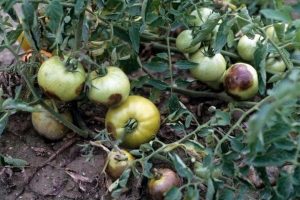 The appearance of small black spots that are hard to touch and without an unpleasant odor - does not indicate any manifestations of the disease. Such “moles” appear from excessive solar activity and tomatoes can be eaten without fear.
The appearance of small black spots that are hard to touch and without an unpleasant odor - does not indicate any manifestations of the disease. Such “moles” appear from excessive solar activity and tomatoes can be eaten without fear.
But if the blackening is soft to the touch, affects a large part of the tomato, has a fur layer and gives off an unpleasant smell, then this is a direct indication of the development of a fungal or viral disease. It also affects the stems and leaves of seedlings.
Blacken tomatoes, what to do?
Pay attention to where the bed is located. The place should be well blown and lit during the daytime. If you grow tomatoes in a greenhouse, make sure that every day fresh air flows into it.
In a week with dry weather, 2 times is enough. Water strictly at the root, sprinkling method for tomatoes is not suitable.
Choose varieties with an average maturity, such give fruit before they have time to get late blight.
Pasykus and pinch the excess air roots, tear off excessively large leaves, as well as leaves with small lesions, darkening.
How to save the harvest?
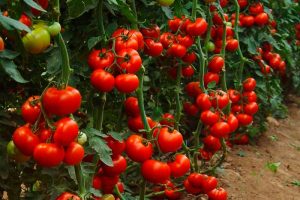 Harvest can be saved even at the stage of seed preparation. Soak them in a disinfecting solution for 20-30 minutes. Before placing in the soil, treat the soil and in any case, do not plant on the place where last year was late blight or other types of fungal diseases.
Harvest can be saved even at the stage of seed preparation. Soak them in a disinfecting solution for 20-30 minutes. Before placing in the soil, treat the soil and in any case, do not plant on the place where last year was late blight or other types of fungal diseases.
In the process of growth, carefully monitor the seedlings and apply mineral fertilizers correctly. As a rule, a lack of magnesium, boron and nitrogen is detected.
Be careful with nitrogen, as it will provoke blackening several times stronger when irrigation is not timely. Treatment does not help, if the seedlings were infected, focus on prevention.
How to process tomatoes so as not to blacken?
Until the formation of the fruit, treat with chemicals and fungicides, during the period of maturation with biological preparations. They are safe both for a crop, and for the person. For example, you can use drugs such as mentronidazole, phytosporin, Agat-25. They should be treated every 2 weeks. The use of traditional methods (for example, spraying iodine and milk solution, processing by spraying dry ash 7 days after planting seedlings) is permissible at the stage of tomato ripening, since substances that are part of the mixtures are safe for humans. Do not forget about the weekly inspection of the bushes and tearing of the affected, dry leaves.
What to process tomatoes so as not to blacken after harvesting?
After collecting the fruits, they can be processed in hot water, or rather heated up for a few minutes. Water temperature should not exceed 60 degrees. Pour water into a bowl of water and place fruit there. Let dry naturally and store.
Choose immature fruits. Do not let the skin of tomatoes curl. Otherwise, their shelf life is reduced to several hours.
How to prevent the spread of the disease?
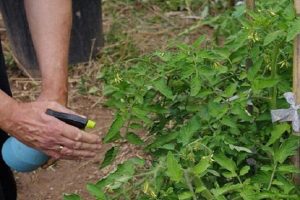 Despite the fact that fungal and viral diseases spread quickly and it is not recommended to eat fruits after infection, preventive measures can be used to prevent the development of diseases.
Despite the fact that fungal and viral diseases spread quickly and it is not recommended to eat fruits after infection, preventive measures can be used to prevent the development of diseases.
Prevention
Fighting folk remedies
Recipe number 1
Take 300 grams of garlic or onions, pour 5-10 liters of water and put the ingredients there. Insist for a day. After filtering and with the help of a garden spray handle the beds with tomatoes.
Recipe number 2
Based on lactic acid bacteria. They do not allow the fungus to develop and prevent the development of diseases. Take 100 grams of fermented milk product and dilute in 1 liter of water.The resulting solution using a spray handle the beds.
Recipe number 3
Mix one glass of salt in 5 liters of water until a homogeneous solution and spray the bushes until the fruit ripens.
Watering
Water the beds early in the morning or in the evening when the sun is not so active. The method of sprinkling is strictly prohibited to apply, especially after treatment with chemicals or biological agents. Water should flow strictly under the root.
Masking
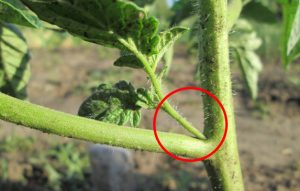 Be sure to pick off all stepchildren and lower leaves of tomatoes. Form low bushes in three stalks, bushes of average height - in two stalks, and high varieties - in one stalk. This will not only protect against the development of the fungus, but also accelerate the growth of fruits.
Be sure to pick off all stepchildren and lower leaves of tomatoes. Form low bushes in three stalks, bushes of average height - in two stalks, and high varieties - in one stalk. This will not only protect against the development of the fungus, but also accelerate the growth of fruits.
Crop rotation
If on the garden you grew something from the family of nightshade (tomatoes, potatoes, eggplants), then again plant the seedlings in the place itself is allowed in 3-4 years. Otherwise, the harvest will suffer the same problems as last year.
Do not plant tomatoes near potatoes, eggplants, as they suffer the same diseases. Cucumbers, onions, garlic, cabbage, corn will be ideal predecessors.
Landing place
Should be located in a draft, the soil should be dry, loamy, low in nitrogen, slightly acidic and well heated.
Varieties of tomatoes that are resistant to fungal diseases
 Sometimes, even under all conditions, the tomatoes become infected with fungal and viral diseases. In order to protect yourself from all sides, choose varieties that are resistant to such illnesses.
Sometimes, even under all conditions, the tomatoes become infected with fungal and viral diseases. In order to protect yourself from all sides, choose varieties that are resistant to such illnesses.
Due to the short period of ripening, they do not have time to pick up the phytophtora, the tip rot or cultures were specially selected with more stable immunity.
Early ripe varieties
|
Name of the variety |
Characteristic |
| Chimgan | Hybrid varietystarting to bear the first fruits in 100-110 days. Fruit weight reaches 300 grams. Without the use of special storage conditions, the shelf life is reduced to 14 days. It has a high resistance to many fungal diseases, including late blight, fusarium, and vertex rot. |
| Dubko | Starts fruiting in 80-100 days after landing in the ground. Fruit weight is relatively small - up to 100 grams. The bush is low, the variety is not a hybrid. It tolerates late blight, resistant to many pests. |
| Orange Miracle | The tomato is derived by Russian breeders. The ripening period is reduced to 100 days. The weight of the fruit, despite the small height of the bush, reaches 250 grams. Resistant to many types of fungal diseases characteristic of the nightshade. |
| Dwarf | The early ripe grade fructifying in 90 days after disembarkation in soil. It is considered one of the smallest varieties since the height of the bush does not exceed 60 cm in height, and the weight of tomatoes is no more than 50 grams. The culture is universal and resistant to late blight, fusarium and other fungal and bacterial diseases. |
Special varieties
|
Name of the variety |
Characteristic |
| Black bunch | The development of Russian breeders, specifically focusing on resistance to all types of fungal diseases. Fruits of black color, resemble large black currants. The ripening period is 80 days. Fruit weight - up to 70 grams. |
| Sovereign | Universal, early variety, suitable for growing in various ways and beginning to bear fruit after 80 days. Fruit weight - up to 200 gr. Included in the state register, as a variety resistant to Alternaria, stolbur, TMM, phytophthora. |
| Stolypin | The early ripe grade bringing tomatoes, weighing 150 gr., In 90 days. Because of the short period of ripening, the phytophtora does not have time to hit the seedlings and the entire crop is preserved without loss. |
| Diva | High-yielding variety bred with high immunity and resistance to fungal diseases. Fruit weight over 200 grams. From the moment of planting to the biological maturity of tomatoes, it takes less than 3 months. |
Tips, secrets
- An extraordinary but working council is to pierce through, stepping back from the bottom of the trunk 3-4 cm, with copper wire the base of the seedling trunk.
- Do not plant bushes too close. The ideal distance between them is at least 30 cm. So, if the disease hits one of the seedlings, it will not have time to spread to other plantings.
- Make timely mineral and complex fertilizers. This will help improve immunity and cope with the fungus.
- If you notice a leaf darkening, but the fruits look healthy, most likely you have gone too far with nitrogen. To stabilize its level in the soil, add sand, peat, and also carefully pour a bed with tomatoes.
- Preheat the seeds in the oven for a few minutes before germinating. Be careful not to burn the seed.
- After each watering spud earth and inspect the leaves, especially their lower part.
Reviews
Michael
He built a greenhouse, as it seemed to me, according to all the rules. Saplings prepared for transplanting into the ground, watered in a timely manner. But then I discovered that almost all the seedlings are affected by a disease, a fungus of some sort. The neighbor said it was because there was no vent in the greenhouse. Yes, I did not know what to air. Next year, be sure to retool the greenhouse, so that the air was fresh.
Alexey
I read somewhere that tomatoes like dry soil and rarely watered. As a result, almost all turned black before they even matured. Looking for the reason why it happened. I realized that due to the fact that there was a lot of nitrogen in the soil, they turned black. And if we watered more often, nothing would have happened. He worked out an ideal schedule - 2 times a week, if the temperature is above +35 degrees.


